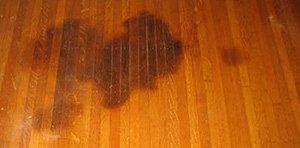Curing Stains on Real Wood Floors
Description
When a wood floor surface has suffered discoloration in relation to the worn areas of flooring, staining has occurred.

Cause
Wood flooring can be worn in a number of ways. One major factor of floors experiencing wearing is through large quantities of traffic passing through that selected area.
Additionally, infrequent and poorly executed maintenance of the floor may lead to wood becoming exposed to contaminants of various sorts. This is a result of the surface finish not providing adequate protection to the wood it has been applied to. The danger here is that certain contaminants can cause the discoloration of a finish itself.
There are multiple ways in which the staining of wood floors may be caused. These include:
- Pets urinating on a wood floor surface.
- Oil or grease not being cleaned from a floor
- The floor receiving excessive moisture which may lead to mildew, decay, graying or white stains caused by alkaline.
- The residues left behind from inadequate cleaning products.
- Redcast, which is the result of a chemical reaction between an acid catalyst finish and bare wood.
- High PH cleaning products which may precipitate Calcium Carbonate from water causing grayish residue to be left on the wood floors surface.
Diagnosis
It is crucial to diagnose the problems that have arisen as precisely as possible in order to find the most suitable solution.
Solutions
Stains on the surface of lacquered finishes
If you possess a lacquered finished floor, the necessary steps to restore your flooring is to clean with a gentle solvent such as mentholated spirit or a recommended cleaner from an experienced wood flooring specialist. This should be followed by applying a refresher polish, then buffing.
Following these procedures may increase the longevity of your floor.
Stains on oiled or waxed finished floors
If on the other hand, you have an oiled or waxed finish on your flooring, you should simply clean with a solvent or use another cleaning product that has been recommended by a professional. This should be followed by using cleaning grade wire wool or light localised sanding if this is necessary.
Refinishing the affected area by applying the chosen oil or wax and complete this step by buffing.
Stains on bare wood (severely worn floors)
Clean the area with a solvent and follow this up by using cleaning grade wire wool. Lightly sand if necessary.
Next, you should apply a phosphorous gel, then scrape and sand the area of concern if flooring has been damaged by pet stains.
Refinishing by applying the lacquer, and make use of a barrier seal primer which will allow proper adhesion of new finish.
Severe penetrating stains may require you to completely replace the affected boards.
Important Note:
Localised finishing is often a satisfactory practice with lacquered floors, and can usually produce acceptable results with oiled or waxed floors. When using untested cleaning methods or products, it is always useful to do a test run on an unseen area of flooring or on a spare piece of wood in order to guarantee that method or product used is a suitable solution for the finish in question.
Avoidance
- Failure to utilise external and internal entrance matting may help to create stains on a wood floor.
- Ensure to protect the floor by using felt pads or castor cups on any furniture feet that may cause some damage
- Regularly sweep or vacuum the flooring to remove potentially abrasive grit that may be unseen as this also causes issue.
- As previously stated, clean regularly with a tried and tested cleaning product.
- Repair any minor damage to avoid more serious work later on. This is in regards to worn areas. This must be completed before contaminants affect the bare wood.

